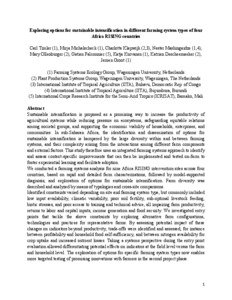Exploring options for sustainable intensification in different farming system types of four Africa RISING countries
Abstract
Sustainable intensification is proposed as a promising way to increase the productivity of agricultural systems while reducing pressure on ecosystems, safeguarding equitable relations among societal groups, and supporting the economic viability of households, enterprises, and communities. In sub-Saharan Africa, the identification and dissemination of options for sustainable intensification is hampered by the large diversity within and between farming systems, and their complexity arising from the interactions among different farm components and external factors. This study therefore uses an integrated farming systems approach to identify and assess context-specific improvements that can then be implemented and tested on-farm to foster experiential learning and facilitate adoption. We conducted a farming systems analysis for nine Africa RISING intervention sites across four countries, based on rapid and detailed farm characterizations, followed by model-supported diagnosis, and exploration of options for sustainable intensification. Farm diversity was described and analyzed by means of typologies and cross-site comparisons. Identified constraints varied depending on site and farming system type, but commonly included low input availability, climatic variability, poor soil fertility, sub-optimal livestock feeding, biotic stresses, and poor access to training and technical advice, all impairing farm productivity, returns to labor and capital inputs, income generation and food security. We investigated entry points that tackle the above constraints by exploring alternative farm configurations, technologies and practices for representative farms. By assessing potential impact of these changes on indicators beyond productivity, trade-offs were identified and assessed, for instance between profitability and household food self-sufficiency, and between nitrogen availability for crop uptake and increased nutrient losses. Taking a systems perspective during the entry point evaluation allowed differentiating potential effects on indicators at the field level versus the farm and household level. The exploration of options for specific farming system types now enables more targeted testing of promising innovations with farmers in the second project phase

